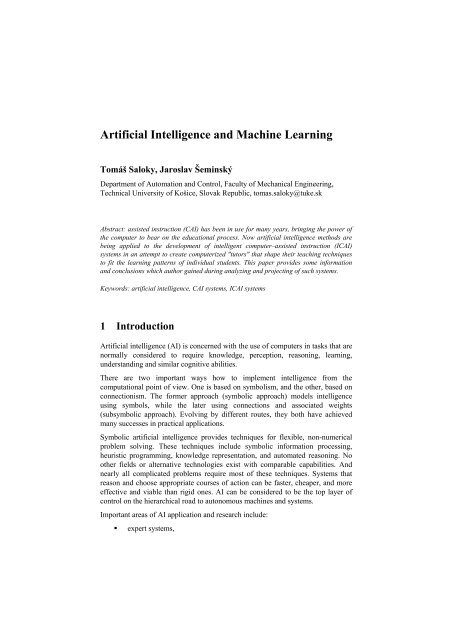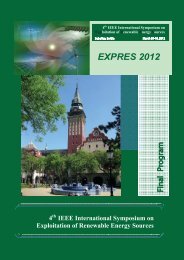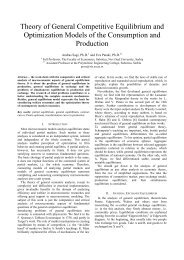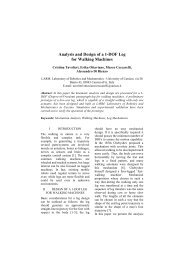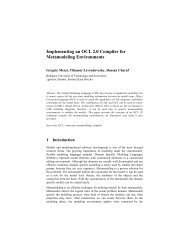Artificial Intelligence and Machine Learning
Artificial Intelligence and Machine Learning
Artificial Intelligence and Machine Learning
Create successful ePaper yourself
Turn your PDF publications into a flip-book with our unique Google optimized e-Paper software.
<strong>Artificial</strong> <strong>Intelligence</strong> <strong>and</strong> <strong>Machine</strong> <strong>Learning</strong><br />
Tomáš Saloky, Jaroslav Šeminský<br />
Department of Automation <strong>and</strong> Control, Faculty of Mechanical Engineering,<br />
Technical University of Košice, Slovak Republic, tomas.saloky@tuke.sk<br />
Abstract: assisted instruction (CAI) has been in use for many years, bringing the power of<br />
the computer to bear on the educational process. Now artificial intelligence methods are<br />
being applied to the development of intelligent computer–assisted instruction (ICAI)<br />
systems in an attempt to create computerized "tutors" that shape their teaching techniques<br />
to fit the learning patterns of individual students. This paper provides some information<br />
<strong>and</strong> conclusions which author gained during analyzing <strong>and</strong> projecting of such systems.<br />
Keywords: artificial intelligence, CAI systems, ICAI systems<br />
1 Introduction<br />
<strong>Artificial</strong> intelligence (AI) is concerned with the use of computers in tasks that are<br />
normally considered to require knowledge, perception, reasoning, learning,<br />
underst<strong>and</strong>ing <strong>and</strong> similar cognitive abilities.<br />
There are two important ways how to implement intelligence from the<br />
computational point of view. One is based on symbolism, <strong>and</strong> the other, based on<br />
connectionism. The former approach (symbolic approach) models intelligence<br />
using symbols, while the later using connections <strong>and</strong> associated weights<br />
(subsymbolic approach). Evolving by different routes, they both have achieved<br />
many successes in practical applications.<br />
Symbolic artificial intelligence provides techniques for flexible, non-numerical<br />
problem solving. These techniques include symbolic information processing,<br />
heuristic programming, knowledge representation, <strong>and</strong> automated reasoning. No<br />
other fields or alternative technologies exist with comparable capabilities. And<br />
nearly all complicated problems require most of these techniques. Systems that<br />
reason <strong>and</strong> choose appropriate courses of action can be faster, cheaper, <strong>and</strong> more<br />
effective <strong>and</strong> viable than rigid ones. AI can be considered to be the top layer of<br />
control on the hierarchical road to autonomous machines <strong>and</strong> systems.<br />
Important areas of AI application <strong>and</strong> research include:<br />
• expert systems,
• natural language processing,<br />
• computer vision,<br />
• robotics,<br />
• intelligent computer-assisted instruction,<br />
• automatic programming,<br />
• planning <strong>and</strong> decision support.<br />
In artificial systems knowledge is most often provided through processes of<br />
hardware engineering <strong>and</strong> software programming.<br />
2 <strong>Learning</strong><br />
<strong>Learning</strong> is defined as the acquiring of knowledge or skill, in a particular domain.<br />
This definition is related to human beings. In psychology, various generalized<br />
definitions of learning have been proposed, <strong>and</strong> many of them interpret learning as<br />
the change in behavior of a being, subject to a given situation, or as a sequence of<br />
his or her repeated experiences in that situation.<br />
In AI, machine learning can be defined as the capability of an AI system to<br />
improve its performance over a period of time. This, of course, assumes the<br />
capability of the system to acquire new knowledge <strong>and</strong> skills as well as its<br />
capability to reorganize the existing knowledge based on the newly acquired<br />
knowledge. <strong>Machine</strong> learning has already grown into a widespread research field<br />
devoted to the seeking of new learning methods <strong>and</strong>/or learning algorithms, as<br />
well as their implementations.<br />
The history of machine learning is rather long <strong>and</strong> can be traced to the mid-1950s.<br />
However, the crucial research work in this field really started much later by<br />
introduction of a series of alternative learning concepts or learning strategies, such<br />
as<br />
• learning from examples<br />
• learning by analogy<br />
• learning by search<br />
• learning by matching<br />
• learning by problem solving<br />
• learning by discovery<br />
• learning by parameter adjustment
• failure-driven learning<br />
• strategy learning<br />
• connectionist learning.<br />
<strong>Learning</strong> can refer to either acquiring new knowledge or enhancing or refining<br />
skills. <strong>Learning</strong> new knowledge includes acquisition of significant concepts,<br />
underst<strong>and</strong>ing of their meanings <strong>and</strong> relationships to each other <strong>and</strong> to the domain<br />
concerned. The new knowledge should be assimilated <strong>and</strong> put in a mentally usable<br />
form before it can be called "learned". Thus, knowledge acquisition is defined as<br />
learning new symbolic information combined with the ability to use that<br />
information effectively.<br />
Skill enhancement applies to motor skills, <strong>and</strong> to cognitive skil1s. One aspect of<br />
skill enhancement, which distinguishes it from knowledge acquisition is the role<br />
which repetition <strong>and</strong> practice plays. Skill enhancement can be interpreted in<br />
biological terms as reinforcing a pattern of neural connections for performing the<br />
desired function.<br />
3 Basic Problems<br />
<strong>Learning</strong> is one of several processes by which world knowledge <strong>and</strong> task<br />
knowledge become embedded in the computing modules of an intelligent system.<br />
In biological systems, knowledge is also provided by genetic <strong>and</strong> growth<br />
mechanisms. In artificial systems, knowledge is most often provided through<br />
processes of hardware engineering <strong>and</strong> software programming.<br />
Going out from the model (that integrates knowledge from research in both natural<br />
<strong>and</strong> artificial systems), which consists of a hierarchical system architecture, then<br />
there are four system elements of intelligence: sensory processing, world<br />
modeling, behavior generation, <strong>and</strong> value judgment.<br />
Through learning, the behavior generation system can acquire new skills, the<br />
world model can be updated, the sensory processing system can refine its ability to<br />
interpret sensory input, <strong>and</strong> new parameters can be instilled in the value judgment<br />
system.<br />
Observations from psychology <strong>and</strong> neural net research suggest that there are at<br />
least three major types of learning: repetition, reinforcement, <strong>and</strong> specific error<br />
correction learning.<br />
Repetition learning occurs due to repetition alone, without any feedback from the<br />
results of action. For this type of learning the gain function g is a small positive<br />
constant. This implies that learning takes place solely on the basis of coincidence<br />
between presynaptic <strong>and</strong> postsynaptic activity. Much more powerful learning
effects can be obtained with reinforcement learning. Reinforcement learning<br />
incorporates feedback from the results of action. In reinforcement learning, the<br />
learning gain factor g(t) varies with time such that it conveys information as to<br />
whether the evaluation computed by the value judgment module was good<br />
(rewarding), or bad (punishing). Reward reinforcement learning in the behavior<br />
generation system is a form of positive feedback. Punishing reinforcement, or<br />
error correcting, learning occurs when g(t) is negative, i.e., punishing.<br />
Error correction learning is a form of negative feedback. With each training<br />
experience, the amount of error is reduced, <strong>and</strong> hence the amount of punishment.<br />
Error correction is therefore self limiting <strong>and</strong> tends to converge toward a stable<br />
results.<br />
In specific error correction, sometimes called teacher learning, not only is the<br />
overall behavioral result g(t) known, but the correct or desired response of each<br />
output neuron is provided by a teacher. Thus the precise error for each neuron is<br />
known.<br />
Teacher learning tends to converge rapidly to stable precise results. Teacher<br />
learning is always error correcting. The teacher provides the correct response, <strong>and</strong><br />
anything different is an error. Therefore, g(t) must always be negative to correct<br />
the error.<br />
Teacher learning may also be used for task skill learning in cases where a high<br />
level behavior generation module can act as a teacher to a lower level behavior<br />
generation module, i.e., by providing desired output responses to specific<br />
comm<strong>and</strong> <strong>and</strong> feedback inputs.<br />
4 Computer-Assisted Instruction Systems<br />
Computer–assisted instruction has been in use for many years, bringing the power<br />
of the computer to bear on the educational process.<br />
Early CAI programs essentially imitated previously existing instructional<br />
materials. For example, a common CAI technique mirrors a method called<br />
programmed instruction. In a programmed instruction text, students read brief<br />
instructional material <strong>and</strong> then are presented with short questions to test their<br />
comprehension. Students turn to different pages of the book, depending on their<br />
answers to the questions, so that each student effectively "programs" a different<br />
path through the material based on individual comprehension abilities.<br />
The CAI technique based on programmed instruction is known as frame-based<br />
CAI. In frame-based CAI, a student responds to problems presented by computer.<br />
The computer is programmed to react differently to possible student responses. If
the student's answer is correct, for example, the computer might display remedial<br />
material <strong>and</strong> then pose a simpler problem.<br />
The effectiveness of frame–based CAI program depends entirely on how well it is<br />
designed. Although many successful programs have been developed, frame–based<br />
CAI programs use computers simply as electronic "page–turners".<br />
5 Intelligent Computer-Assisted Instruction Systems<br />
Adding AI techniques to CAI results in an effective, new instructional method<br />
called Intelligent Computer-Assisted Instruction. The goal of ICAI is the<br />
development of instructional materials that actually analyze a student's<br />
performance in order to develop individualized tutoring strategies.<br />
The main components of an ICAI system are:<br />
• problem–solving expertise,<br />
• student model, <strong>and</strong><br />
• tutoring module.<br />
The problem–solving expertise component of an ICAI program contains the<br />
knowledge that system tries to impart to the student. This expertise is represented<br />
with techniques similar to those used in the knowledge base of an expert system.<br />
In fact, this component can be thought of as a specialized expert system that<br />
contains expertise in domain of the ICAI program. The student model, a<br />
representation of the student's underst<strong>and</strong>ing of the domain, is an important<br />
element of ICAI. If a student is experiencing difficulty with certain material, the<br />
student model analyzes the student's performance to ascertain the specific causes<br />
of the problem. By identifying response patterns, the student model determines the<br />
student's misconceptions <strong>and</strong> discovers the exact causes of erroneous reasoning.<br />
Once the student model has determined the causes of a student's problem, an ICAI<br />
program decides how to correct the problem. The component of the program that<br />
selects the strategies for presenting tutorial information to students is called the<br />
tutoring module. Various strategies may be used to ensure that students underst<strong>and</strong><br />
both the causes of their errors <strong>and</strong> the actions necessary to correct them. A<br />
tutoring module generally incorporates natural language processing techniques to<br />
communicate at the level of each individual student.<br />
Conclusions<br />
An intelligent computer-assisted instruction program analyzes a student's<br />
performance <strong>and</strong> develops individualized tutoring strategies to identify <strong>and</strong> correct<br />
learning problems.
ICAI is the area of AI research with the goal of creating training programs that can<br />
analyze a student's learning pattern <strong>and</strong> modify their teaching techniques<br />
accordingly.<br />
Intelligent CAI systems may produce one of the most dramatic changers of all.<br />
Systems that will enable students to ask questions <strong>and</strong> receive insightful answers<br />
may begin to overcome the barriers of instruction by machines. Computer systems<br />
that model the student based on his or her response can gear instruction to the<br />
student's level of ability <strong>and</strong> interest, something not easily done in a conventional<br />
classroom.<br />
To truly learn is to digest <strong>and</strong> make the material one's by updating one's internal<br />
models <strong>and</strong> using them in new applications. Real-time interaction with a computer<br />
providing immediate feedback <strong>and</strong> individual guidance is particularly appropriate<br />
to this goal.<br />
Acknowledgements<br />
This paper provides some information <strong>and</strong> conclusions which author gained<br />
during analyzing <strong>and</strong> projecting of such systems within the frame of “KEGA”<br />
research project ”Virtual Program Modules of AI Systems”.<br />
References<br />
[1] Saloky, T.: Applications of <strong>Artificial</strong> <strong>Intelligence</strong> Techniques. Košice: Elfa,<br />
Košice, 1993. ISBN 80-7079-227-1<br />
[2] Góts, I.- Saloky, T.: Scientific Research <strong>and</strong> Pedagogical Aspects of the<br />
Doctoral Study at the Faculty of Mechanical Engineering. In Proceedings<br />
of AE in ACT’94. International Workshop on Advanced Education <strong>and</strong><br />
Control Technology. Prague: CTU, Prague, 1994, pp. 31-34<br />
[3] Saloky, T.: Applications of <strong>Machine</strong> <strong>Learning</strong> Techniques. Košice: Elfa,<br />
Košice, 1998. ISBN 80-88786-73-8


